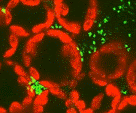Plant Pathology, Department of

Department of Plant Pathology: Faculty Publications
Document Type
Article
Date of this Version
9-12-2019
Citation
Palmer NA, Chowda-Reddy RV, Muhle AA, Tatineni S, Yuen G, Edme´ SJ, et al. (2019) Transcriptome divergence during leaf development in two contrasting switchgrass (Panicum virgatum L.) cultivars. PLoS ONE 14(9): e0222080. https:// doi.org/10.1371/journal.pone.0222080
Abstract
The genetics and responses to biotic stressors of tetraploid switchgrass (Panicum virgatum L.) lowland cultivar ‘Kanlow’ and upland cultivar Summer are distinct and can be exploited for trait improvement. In general, there is a paucity of data on the basal differences in transcription across tissue developmental times for switchgrass cultivars. Here, the changes in basal and temporal expression of genes related to leaf functions were evaluated for greenhouse grown ‘Kanlow’, and ‘Summer’ plants. Three biological replicates of the 4th leaf pooled from 15 plants per replicate were harvested at regular intervals beginning from leaf emergence through senescence. Increases and decreases in leaf chlorophyll and N content were similar for both cultivars. Likewise, multidimensional scaling (MDS) analysis indicated both cultivar-independent and cultivar-specific gene expression. Cultivar-independent genes and gene-networks included those associated with leaf function, such as growth/ senescence, carbon/nitrogen assimilation, photosynthesis, chlorophyll biosynthesis, and chlorophyll degradation. However, many genes encoding nucleotide-binding leucine rich repeat (NB-LRRs) proteins and wall-bound kinases associated with detecting and responding to environmental signals were differentially expressed. Several of these belonged to unique cultivar-specific gene co-expression networks. Analysis of genomic resequencing data provided several examples of NB-LRRs genes that were not expressed and/or apparently absent in the genomes of Summer plants. It is plausible that cultivar (ecotype)-specific genes and gene-networks could be one of the drivers for the documented differences in responses to leaf-borne pathogens between these two cultivars. Incorporating broad resistance to plant pathogens in elite switchgrass germplasm could improve sustainability of biomass production under low-input conditions.

